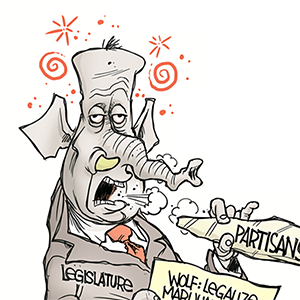Business
/ArcaMax

Michigan consumer sentiment index shows how much Americans' confidence is shattered
Economists predict a spending pullback by U.S. consumers because their sentiment fell for a fourth consecutive month, plunging to its second-lowest level in more than 70 years, as back-and-forth, on-again, off-again tariffs whipsaw Americans.
The 11% decrease from March in the preliminary results for April of the University of Michigan's Survey...Read more

Michael Hiltzik: No one understands Trump's thinking on tariffs. Here are the top guesses
For a brief, shining moment Wednesday, it looked as though some semblance of sanity had crept into Donald Trump's trade war.
Trump abruptly reversed course on the "reciprocal" tariffs he had begun to impose on scores of America's leading trading partners and other countries. He dictated a 90-day pause in those tariffs, while simultaneously ...Read more
Amid tariff turmoil, Swiss drugmaker commits to build $1.1B research hub in San Diego
Swiss pharmaceutical giant Novartis announced Thursday that it plans to build a $1.1 billion research hub in San Diego as part of its $23 billion investment in U.S. operations over the next five years.
The investment will create nearly 1,000 new jobs at Novartis and about 4,000 additional jobs in the U.S. as the company plans to construct seven...Read more

Tax Day is Tuesday. Are you ready? Tips for late filers
For many tax filers, state and federal income taxes are due Tuesday.
If you are done working on your 2024 taxes, congratulations.
If you have not, The San Diego Union-Tribune hopes the last-minute tax filing tips below, from one San Diego finance professional and the Internal Revenue Service, make the coming days a little bit less of a drag.
...Read more

Trump administration takes aim at California's cap and trade program
There’s another battle brewing between the Trump administration and California.
A White House executive order issued earlier this week wants to roll back what it calls “all illegitimate impediments” by various state to develop U.S. energy resources and called out California’s cap and trade program that has been in place since 2012.
But...Read more

S&P 500 notches its best week since November 2023: Markets wrap
Wall Street’s gyrations shook markets anew, with stocks wiping out losses to extend their best weekly gain since 2023. The rebound came as a selloff in Treasuries and the dollar abated, following a few chaotic days that underscored fears foreign investors are beating a retreat from American assets.
Volatility shows little signs of easing as ...Read more

UAW says automakers can afford tariffs. This is how much they'll cost, according to new report
Detroit's three automakers could bear an additional $41.9 billion in annual costs from President Donald Trump's 25% tariffs on imported vehicles and parts, according to new estimates.
An analysis from the Center for Automotive Research in Ann Arbor, Michigan — commissioned by the American Automotive Policy Council, a Detroit Three advocacy ...Read more

Theranos fraudster Elizabeth Holmes keeps fighting, claims appeal judges were confused, illogical and factually mistaken
Felonious Theranos fraudster Elizabeth Holmes has launched another appeal of her conviction and sentence, claiming that a three-judge panel that shot down her first appeal in February was confused on one point, illogical on another, and made factual mistakes in hearing her case.
Holmes, 41, was convicted on four counts of felony criminal fraud ...Read more

Car prices going up due to tariffs? What dealers and brands are doing in response
President Donald Trump's new 25% automotive tariffs are set to push new car prices thousands of dollars higher, but some automakers and dealers are sending a message that for now, at least, there are still hot deals to be found.
Ford Motor Co. began offering employee pricing to all customers last week, just as the tariffs on new car imports ...Read more

Stocks eye best week since '23 as bond rout eases: Markets wrap
Wall Street’s gyrations shook markets anew on Friday, with stocks wiping out losses to extend their biggest rally since 2023 as a selloff in bonds waned.
Volatility shows little signs of easing as concerns that President Donald Trump’s fast-evolving trade policy is not only shaking the globe but threatening the U.S. status as the world’s ...Read more

Auto review: 1967 Pontiac Grand Prix convertible is 'one rare chief'
As my long-term readers know about my array of cars in my collection and with an outpouring amount of emails requesting a review on something from within the Grasso Garage stable. Well, that time is here, so let’s strap in and take a drive down memory lane together, with one of Grasso’s Garage favorites.
Grasso’s Garage is proud to review...Read more

Auto review: Burnin' rubber in the loco Ford Maverick Lobo
SAN DIEGO, Calif. — Rounding the 180-degree, left-hand bend at the east end of Pechanga Arena’s autocross course, I stabbed the throttle pedal of my 2025 Ford Maverick Lobo and twin clutch packs accelerated the pickup’s outside rear wheel. SQUAAAWWWWWWWW! The tires squealed in protest as I drifted sideways through the next gate of pylons ...Read more

'It's going to hurt a lot.' How LA's importers are navigating Trump's shifting tariffs
Since immigrating to the United States in 2009, Riyad Ladadwa has made a living buying and selling produce. The Palestinian businessman owns Diamond Fresh Farmers Market in Diamond Bar and relies on goods shipped from Mexico and other countries.
Ladadwa said his business is successful because he’s able to offer inexpensive products, but as ...Read more

Why Trump's dream of made-in-the-USA iPhones isn't going to happen
For U.S. President Donald Trump, there would be few bigger victories than having a domestically produced version of the iPhone, one of the most popular tech products in history. Such a prize would validate his tariff plan and campaign promise to bring manufacturing jobs back to America.
And the administration clearly feels this is an achievable...Read more

7 investing mistakes financial pros say you should avoid
Investing in 2025 is more accessible than ever — but it isn’t always easy. With nearly constant market volatility and financial advice flooding your social media feed, it’s easy to make mistakes that hurt your long-term returns.
Whether you have $5 or $500,000, avoiding these common traps can save you from costly mistakes and future ...Read more

Larry Printz: Kia throws down the gauntlet once again at Milan Design Week
Milan Design Week, which is just wrapping up, is an annual affair that draws in the biggest names in fashion, such as Armani, Dior, Hermès, Bottega Veneta, Brunello Cucinelli, Dolce & Gabbana, Prada and Versace. Yet increasingly you’ll find automakers there as well, and this year’s attendees included Bentley, Bugatti, Jaguar Land Rover, ...Read more

Auto review: Reimagined QX80 ups its game on luxury, tech, power
The 2025 Infiniti QX80 enters its third generation and it’s a big deal — make that a gigantic deal.
The long-awaited redesign (more than a decade) expands the length of the large luxury SUV to 17.5 feet. It is slightly wider and taller, too, and weighs around three tons. It’s also more powerful than ever and can tow up to 8,500 pounds.
...Read more

DoorDash rolls out food delivery robots in Los Angeles
A robot on wheels could serve up your next meal thanks to a partnership between DoorDash and Coco Robotics that's bringing food delivery robots to Los Angeles sidewalks.
The food delivery service DoorDash announced Thursday that eligible customers in Los Angeles and Chicago can order food through their app to be delivered by a small, box-shaped...Read more

Bessent emerges as Wall Street man-of-the-hour trade negotiator
Treasury Secretary Scott Bessent wasn’t directly involved in setting the steepest American tariff rates since before World War II. But he’s now in charge of negotiations to avoid them getting implemented.
The former hedge fund manager has vaulted to the front of the line in President Donald Trump’s list of advisers in recent days, in a ...Read more

US allies greet Trump's tariff u-turn with relief, and defiance
America’s trading partners around the globe reacted with a mixture of relief and bewilderment to President Donald Trump’s eleventh-hour decision to pause some of his most aggressive tariffs.
As government officials worldwide try to divine what would convince Trump to grant them permanent waivers, his newly demonstrated willingness to ...Read more
Popular Stories
- Michael Hiltzik: No one understands Trump's thinking on tariffs. Here are the top guesses
- Michigan consumer sentiment index shows how much Americans' confidence is shattered
- Tax Day is Tuesday. Are you ready? Tips for late filers
- Amid tariff turmoil, Swiss drugmaker commits to build $1.1B research hub in San Diego
- Trump tariffs are another nail in the coffin for Hollywood in China










